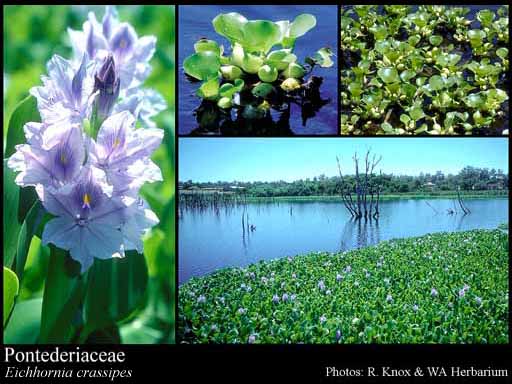- Reference
- Nov.Gen.Sp. 1:265 (1816)
- Name Status
- Current







Scientific Description
Common name. Water-Hyacinth Family.
Habit and leaf form. Aquatic herbs. Leaves well developed, or much reduced (in Hydrothrix). Plants more or less succulent (the branches and petioles spongy and aerenchymatous). Annual, or perennial; plants with a basal concentration of leaves, or with neither basal nor terminal concentrations of leaves. Hydrophytic; free floating, or rooted. Leaves submerged, or emergent, or floating; alternate (usually), or whorled; spiral, or distichous (usually); petiolate; sheathing. Leaf sheaths tubular. Leaves simple. Leaf blades entire; linear, or lanceolate, or ovate, or orbicular (or in Hydrothrix dissolved into undifferentiated, filiform strands); palmately veined to parallel-veined (convergent), or pinnately veined (pinnate-parallel); without cross-venules; cordate, or attenuate at the base. Leaves ligulate, or eligulate; with stipules (if the axillary hyaline structures are so interpreted), or without stipules. Leaf blade margins entire. Stem anatomy. Secondary thickening absent.
Reproductive type, pollination. Fertile flowers hermaphrodite. Unisexual flowers absent. Plants hermaphrodite. Plants homostylous, or heterostylous. Floral nectaries present, or absent (Heteranthera). Nectar secretion when occurring, from the gynoecium (via septal nectaries). Usually entomophilous (apart from Heteranthera).
Inflorescence and flower features. Flowers solitary, or aggregated in ‘inflorescences’; in racemes, or in spikes, or in panicles. The terminal inflorescence unit cymose, or racemose. Inflorescences terminal; spatheate, or espatheate. Flowers small to medium-sized; regular to very irregular; when irregular, zygomorphic. The floral asymmetry involving the perianth, or involving the perianth and involving the androecium. Flowers 3 merous; tetracyclic, or pentacyclic. Perigone tube present (often), or absent. Perianth of ‘tepals’; 6; 2 -whorled; isomerous; free, or joined; petaloid; without spots, or spotted; similar in the two whorls; white, or violet, or blue, or yellow (rarely). Androecial members definite in number. Androecium (3–)6. Androecial members free of the perianth; all equal, or markedly unequal; 1 -whorled, or 2 -whorled (usually, 3+3). Androecium exclusively of fertile stamens, or including staminodes. Staminodes when present, 2, or 3. Stamens 1 (e.g. Hydrothrix), or 3 (Heteranthera spp.), or 6; reduced in number relative to the adjacent perianth, or isomerous with the perianth, or diplostemonous; alterniperianthial, or oppositiperianthial (when 3). Anthers basifixed (or peltate); dehiscing via longitudinal slits, or dehiscing via pores; introrse. Gynoecium 3 carpelled. The pistil 1 celled, or 3 celled. Carpels isomerous with the perianth. Gynoecium syncarpous (sometimes pseudomonomerous); synstylovarious to eu-syncarpous; superior. Ovary unilocular, or plurilocular; 3 locular, or 1 locular (by abortion). Gynoecium stylate. Styles 1; attenuate from the ovary; apical. Stigmas 1; 3 - lobed; dry type; papillate; Group II type. Placentation when unilocular, parietal (with intruded placentas); when trilocular, axile. Ovules in the single cavity when unilocular, 1; usually 10–50 per locule (‘many’); pendulous; non-arillate; anatropous.
Fruit and seed features. Fruit non-fleshy; dehiscent (when trilocular), or indehiscent (when pseudomonomerous); a capsule, or a nut (when pseudomonomerous/indehiscent). Capsules loculicidal. Seeds endospermic. Endosperm not oily. Seeds with starch. Embryo well differentiated. Cotyledons 1. Embryo straight. Seedling. Hypocotyl internode absent. Mesocotyl absent. Seedling collar not conspicuous. Cotyledon hyperphyll elongated; assimilatory; dorsiventrally flattened. Coleoptile absent. First leaf dorsiventral. Primary root ephemeral.
Physiology, biochemistry. Photosynthetic pathway: C3.
Geography, cytology, number of species. World distribution: pantropical, subtropical and warm temperate. 30 species.
Economic uses, etc. Some watergarden ornamentals, including Eichhornia (water hyacinth) which is a devastating weed of waterways.